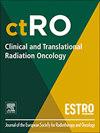Acute enteritis with pelvic SBRT: Influence of bowel delineation methods
IF 2.7
3区 医学
Q3 ONCOLOGY
引用次数: 0
Abstract
Purpose
One fourth of the patients receiving SBRT to prostate and pelvis develop mild to moderate acute enteritis. In this study, we aim to study bowel dosimetry for different methods of bowel delineation in patients with and without acute bowel toxicity after whole-pelvic SBRT (WP-SBRT).
Methods and materials
In this prospective study, patients with high-risk prostate cancer treated with WP-SBRT were identified. Patients with acute bowel toxicity (CTCAE v5.0) were included as cases while those without were controls. All the patients had previously received 35–36.25 Gy in 5 fractions to the prostate and 25 Gy in 5 fractions to the pelvis. The bowel was contoured on the planning CT scan using seven different methods, namely- bowel bag (BB), small bowel loop (SB), large bowel loop (LB), combined bowel loop (BL) and bowel loops with margins (BL + 0.5 cm, BL + 1 cm and BL + 1.5 cm). The original clinically used plan was applied to all the contouring methods and dose-volume parameters studied.
Results
A total of 102 patients treated with WP-SBRT were screened and only those with properly documented acute toxicity were included for further analysis. While none of the patients had grade 3 bowel toxicity, 23 (22.5 %) patients had grade 1–2 acute enteritis, and 23 patients without were selected as cases and controls respectively. On visual assessment, the composite dose volume histogram (DVH) were similar for cases and controls for all the delineation methods studied. Objectively, the volume of the bowel structures receiving 7 Gy, 14 Gy, and 25 Gy did not show any statistically significant difference between cases and controls. One in five patients treated with WP-SBRT using bowel bag dose constraints of V7 < 1500 cc, V14 < 500 cc and V25 < 50 cc had acute enteritis.
Conclusion
There was no significant difference in planned bowel doses for different bowel delineation methods in patients with prostate cancer treated with WP-SBRT with or without acute bowel toxicity.
急性肠炎伴盆腔SBRT:肠描绘方法的影响
目的前列腺盆腔SBRT术后1 / 4的患者发生轻至中度急性肠炎。在这项研究中,我们的目的是研究肠道剂量学在全盆腔SBRT (WP-SBRT)后有无急性肠道毒性患者的不同肠道描绘方法。方法和材料在这项前瞻性研究中,确定了接受WP-SBRT治疗的高危前列腺癌患者。有急性肠毒性(CTCAE v5.0)的患者作为病例,没有急性肠毒性的患者作为对照组。所有患者先前均接受35-36.25 Gy的5次前列腺照射和25 Gy的5次骨盆照射。在计划CT扫描上采用7种不同的方法对肠道进行轮廓,即-肠袋(BB),小肠袢(SB),大肠袢(LB),合并肠袢(BL)和有边缘的肠袢(BL + 0.5 cm, BL + 1 cm和BL + 1.5 cm)。原始临床使用的方案应用于所有轮廓方法和研究的剂量-体积参数。结果共筛选了102例接受WP-SBRT治疗的患者,仅纳入有适当记录的急性毒性患者进行进一步分析。没有患者出现3级肠毒性,23例(22.5%)患者出现1-2级急性肠炎,23例未出现急性肠炎的患者分别作为病例和对照组。在目视评估中,所有研究的描绘方法中,病例和对照组的复合剂量体积直方图(DVH)相似。客观地说,接受7 Gy、14 Gy和25 Gy的肠结构体积在病例和对照组之间没有统计学上的显著差异。五分之一的WP-SBRT患者使用肠袋剂量限制V7和lt;1500cc, V14 <;500cc和V25 <;50毫升急性肠炎。结论WP-SBRT治疗的前列腺癌患者在有无急性肠毒性的情况下,不同肠描绘方法的计划肠剂量无显著差异。
本文章由计算机程序翻译,如有差异,请以英文原文为准。
求助全文
约1分钟内获得全文
求助全文
来源期刊

Clinical and Translational Radiation Oncology
Medicine-Radiology, Nuclear Medicine and Imaging
CiteScore
5.30
自引率
3.20%
发文量
114
审稿时长
40 days
 求助内容:
求助内容: 应助结果提醒方式:
应助结果提醒方式:


